Philippe Mercier stands as a significant, if sometimes overlooked, figure in the transition of artistic tastes in eighteenth-century England. Born in Berlin to a family of French Huguenot exiles, Mercier's career would see him absorb influences from across Europe before he ultimately made his mark on the British art scene. As a painter and etcher, he played a crucial role in introducing and popularizing the Rococo style, particularly through his charming conversation pieces and evocative "fancy pictures." His connection with the circle of Frederick, Prince of Wales, further cemented his position, allowing him to influence a generation of artists and patrons. This exploration delves into Mercier's life, his artistic development, the cultural context of his work, his key achievements, and his lasting legacy.
Early Life and Artistic Formation
Philippe Mercier was born in Berlin, the capital of Brandenburg-Prussia, likely in 1689, though some sources suggest 1691. His father was a Huguenot tapestry worker who had fled France following the Revocation of the Edict of Nantes in 1685, which ended religious tolerance for Protestants. This Huguenot heritage was common among many skilled artisans and intellectuals who sought refuge in Protestant countries like Prussia, the Netherlands, and England, often bringing with them French cultural sensibilities. Berlin, under enlightened rulers, was becoming a haven for such refugees, and Mercier grew up in this environment of cultural exchange.
His formal artistic training began in Berlin, likely at the Prussian Academy of Arts (Akademie der Künste). A pivotal part of his early education was his apprenticeship under Antoine Pesne (1683–1757). Pesne, a Frenchman who had become court painter to King Frederick William I of Prussia and later to Frederick the Great, was a leading exponent of the Rococo style in Germany. Pesne's own training had included time in Paris and Italy, and his work was characterized by its elegance, refined portraiture, and decorative flair. Under Pesne, Mercier would have been immersed in the prevailing aesthetics of French Rococo, learning the techniques of portraiture and decorative painting that were fashionable in European courts.
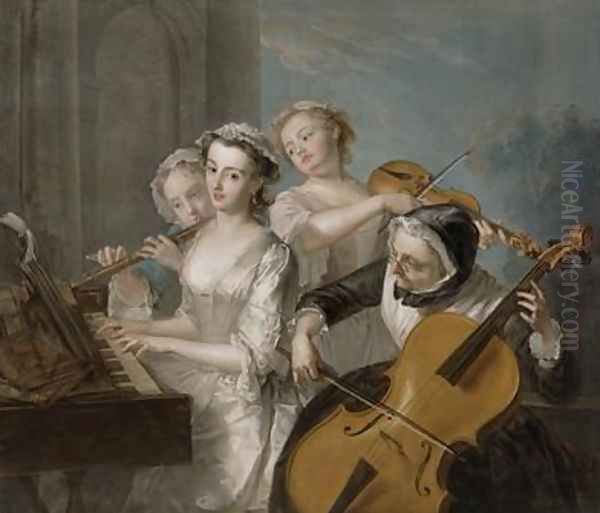
Following his studies in Berlin, Mercier, like many aspiring artists of his time, embarked on a period of travel to further hone his skills and broaden his artistic horizons. He is known to have journeyed through Italy and France, the two epicenters of artistic innovation and classical tradition. In Italy, he would have encountered the masterpieces of the Renaissance and Baroque, as well as the burgeoning Rococo tendencies in cities like Venice, perhaps encountering the work of artists like Rosalba Carriera or Giovanni Battista Tiepolo. His time in France would have brought him into direct contact with the heart of the Rococo movement, where artists like Jean-Antoine Watteau (1684–1721) were revolutionizing painting with their fêtes galantes and scenes of refined, often melancholic, leisure. The influence of Watteau, in particular, would become a defining characteristic of Mercier's subsequent work. He also spent time in Germany before eventually deciding to establish his career elsewhere.
Arrival and Establishment in England
Around 1716, Philippe Mercier made the significant move to London. England, at this time, was a burgeoning economic power with a wealthy aristocracy and a growing middle class eager to patronize the arts. The Hanoverian succession in 1714 had brought George I to the throne, and London was a vibrant, cosmopolitan city. For an artist with French training and a Rococo sensibility, England offered promising opportunities, particularly as native English painting was still developing its own distinct voice in the grander European styles.
Upon settling in London, Mercier began to establish himself, initially likely working on various commissions. His French training and the fashionable Rococo style he espoused would have been attractive to patrons seeking a touch of continental elegance. He married in London in 1719, to Margaret Plante, and began to build a family and a professional life. His early years in England were crucial for adapting his style to English tastes and for building a network of clients.
A significant turning point in Mercier's career came with his association with Frederick, Prince of Wales (1707–1751), the son of King George II. Around 1729, Mercier was appointed Principal Painter to the Prince, and later, in 1730, he also took on the role of Librarian at the Prince's independent establishment at Leicester Fields (now Leicester Square). This royal patronage was immensely prestigious and provided Mercier with a steady stream of commissions, as well as access to the highest echelons of society. Frederick was a known patron of the arts, often at odds with his parents, and cultivated his own court of artists and intellectuals. Mercier's role involved painting portraits of the Prince, his wife Princess Augusta, their children, and members of their circle.
This period saw Mercier at the height of his popularity and influence. He was instrumental in popularizing the "conversation piece," a genre of informal group portraiture that depicted families or groups of friends in relaxed, everyday settings, often engaged in activities like music-making, tea-drinking, or games. These works offered a more intimate and less formal alternative to the grand, official portraiture that had previously dominated.
Artistic Style: Rococo Sensibilities and English Adaptations
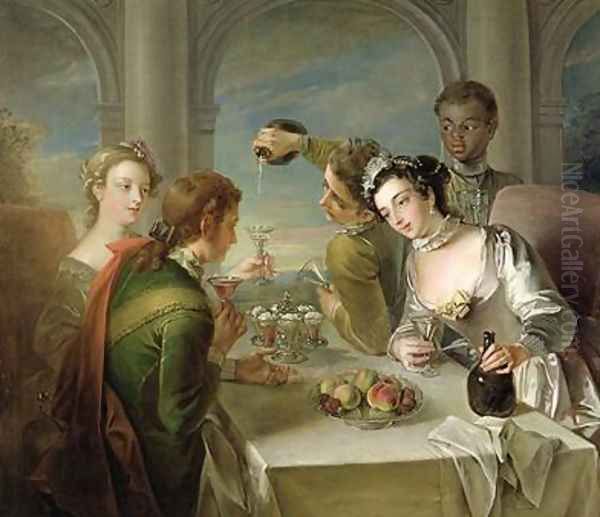
Philippe Mercier is best understood as a key figure in the transplantation of the French Rococo style to English soil. His art is characterized by its charm, delicacy, and an often playful or sentimental mood, all hallmarks of the Rococo. However, he adapted these continental trends to suit the preferences and social context of his English clientele.
The most profound influence on Mercier's style was undoubtedly Jean-Antoine Watteau. Mercier's work frequently echoes Watteau's fêtes galantes – idyllic scenes of aristocratic figures in parkland settings, engaged in amorous or leisurely pursuits. Mercier, however, often translated these themes into a more domestic and recognizably English context. His figures, while elegant, tend to be less ethereal and more grounded than Watteau's. He captured the textures of fabrics, the play of light, and the subtle interactions between his subjects with a refined touch. Artists like Nicolas Lancret and Jean-Baptiste Pater, followers of Watteau, also worked in a similar vein, and their widespread popularity through engravings helped to disseminate this style.
Beyond Watteau, Mercier also seems to have absorbed elements from other French contemporaries. The influence of Jean-Baptiste-Siméon Chardin (1699–1779) can be discerned in some of Mercier's "fancy pictures." Chardin was renowned for his quiet, intimate genre scenes depicting domestic life and childhood with a remarkable sense of realism and empathy. Mercier's fancy pictures, which often featured children, servants, or figures engaged in everyday activities, sometimes share this Chardinesque sensitivity and focus on the ordinary, albeit often sentimentalized.
In England, Mercier's primary genres were the portrait, the conversation piece, and the "fancy picture." His portraits, particularly those for the Prince of Wales's circle, combined Rococo elegance with a degree of informality. He was adept at capturing a likeness while imbuing his sitters with a fashionable grace.
The conversation piece was perhaps where Mercier made his most distinctive contribution in England. While artists like William Hogarth (1697–1764) were also developing this genre, Mercier's approach was typically gentler and more focused on polite sociability than Hogarth's often satirical or moralizing narratives. Mercier's conversation pieces, such as The Schutz Family and Their Friends or scenes depicting musical parties, emphasized harmonious social interaction and domestic contentment. Other English artists like Joseph Highmore (1692–1780) and Arthur Devis (1712–1787) also became prominent practitioners of the conversation piece, each with their own stylistic nuances, contributing to a distinctly English mode of informal group portraiture.
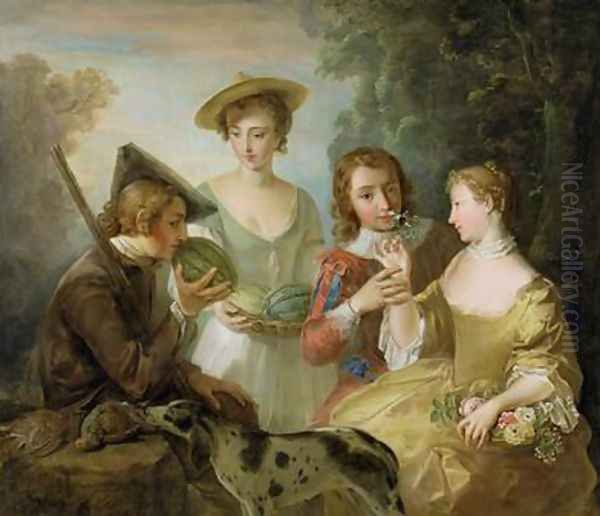
"Fancy pictures" were another important aspect of Mercier's output. These were idealized genre scenes, often featuring charming or sentimental subjects like children playing, young women reading, or figures representing the Five Senses. These works were not specific portraits but were intended to be decorative and to evoke a particular mood or sentiment. They found a ready market among the burgeoning middle class as well as aristocratic patrons.
Mercier was also an accomplished etcher, producing prints after his own paintings and those of other artists. Engravings played a vital role in disseminating artistic styles and images in the 18th century, and Mercier's involvement in printmaking helped to further popularize his work and the Rococo aesthetic. Engravers like the Frenchman Hubert-François Gravelot (1699–1773), who also spent considerable time in England, were instrumental in shaping English Rococo design through book illustrations and ornamental prints, creating a receptive environment for Mercier's paintings. Similarly, French decorative painters like Andien de Clermont (active c. 1716–1783), known for his singerie (scenes with monkeys in human attire), contributed to the Rococo fashion in English interiors.
Major Patrons and Royal Connections
The patronage of Frederick, Prince of Wales, was undoubtedly the cornerstone of Philippe Mercier's success in England during the 1730s. Frederick, often in political opposition to his father, King George II, and his chief minister Sir Robert Walpole, established a rival court at Leicester House. This court became a center for opposition politicians, writers, and artists. Frederick consciously cultivated an image as a man of taste and a supporter of the arts, contrasting himself with what was perceived as the more philistine court of his father.
Mercier's appointment as Principal Painter and Librarian to the Prince placed him at the heart of this alternative cultural sphere. In these roles, he was responsible for creating numerous portraits of Frederick, his wife Princess Augusta of Saxe-Gotha, and their growing family. These portraits often presented the royal family in a more relaxed and intimate manner than was typical for state portraiture, reflecting the Rococo preference for informality and charm. Works like Frederick, Prince of Wales, and His Sisters Playing Music (circa 1733) exemplify this approach, depicting the royal siblings engaged in a domestic musical performance, emphasizing harmony and refined leisure.
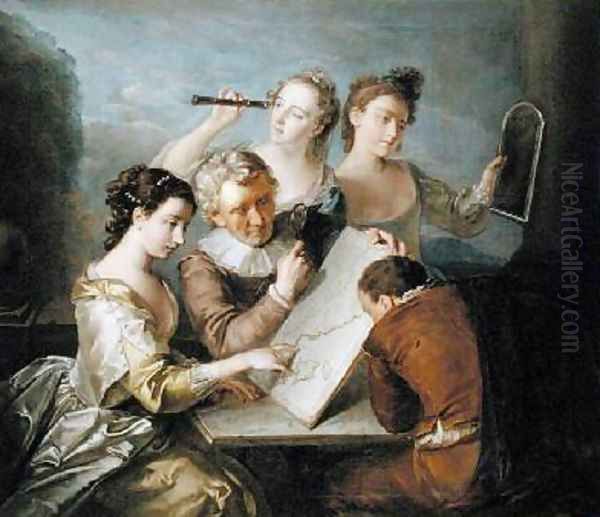
His position also brought him commissions from other members of the Prince's circle and the wider aristocracy. The cachet of royal approval significantly boosted his reputation and desirability as a painter. However, this close association with Prince Frederick was not without its drawbacks. Court politics were notoriously fickle, and by around 1736, Mercier appears to have fallen out of favor with the Prince, or perhaps his style was superseded by newer trends or artists. The reasons for this decline in royal patronage are not entirely clear, but it marked a shift in Mercier's career.
Despite losing his formal position with the Prince, Mercier continued to work as a portraitist and painter of genre scenes. He left London for a period, working in Yorkshire and other parts of the country from around 1739 to 1751, finding patronage among the provincial gentry. This phase of his career demonstrates his adaptability and the widespread appeal of his style beyond the confines of the capital. He eventually returned to London in 1751, the year of Prince Frederick's death.
Key Works and Thematic Concerns
Philippe Mercier's oeuvre is diverse, but certain works and thematic concerns stand out, illustrating his artistic preoccupations and his contribution to 18th-century art.
One of his most celebrated series of "fancy pictures" is The Senses, painted in the 1740s. This set of five paintings, each depicting a female figure personifying one of the senses (Sight, Hearing, Smell, Taste, Touch), showcases Mercier's delicate Rococo style and his ability to create charming, slightly suggestive genre scenes.
The Sense of Hearing (often represented by a woman playing a lute or listening to music) captures the Rococo fascination with music and refined entertainment.
The Sense of Taste (perhaps a woman enjoying fruit or wine) appeals to the sensual enjoyment of earthly pleasures.
The Sense of Smell (a woman with flowers) evokes delicate perfumes and the beauty of nature.
The Sense of Sight (often a woman looking in a mirror or reading) touches on themes of vanity, introspection, or intellectual pursuit.
The Sense of Touch (perhaps a woman caressing a pet or reacting to a sensation) explores tactile experiences.
These paintings are characterized by their soft brushwork, pastel color palettes, and graceful figures, often set in intimate domestic interiors or idyllic outdoor settings. They were highly popular and widely disseminated through engravings, influencing other artists and contributing to the fashion for such sentimental and decorative subjects.
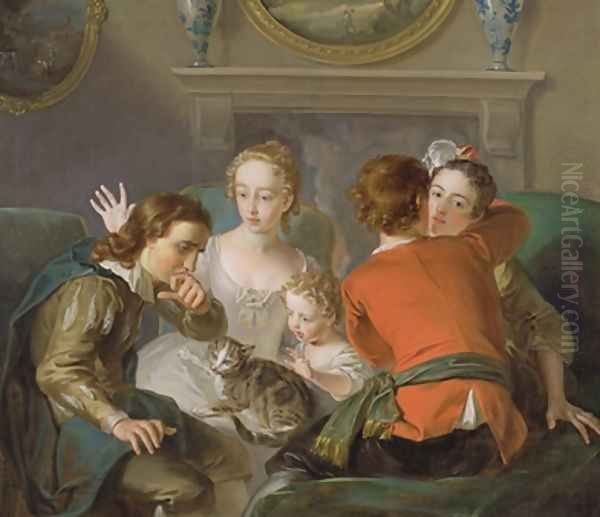
His royal portraits and conversation pieces are also central to his legacy. Frederick, Prince of Wales, and His Sisters (Anne, Amelia, and Caroline) is a prime example. The painting depicts the royal siblings making music together: Frederick plays the cello, while his sisters play other instruments or sing. The composition is informal yet elegant, emphasizing familial harmony and cultural refinement. It’s a departure from the stiff formality of much earlier royal portraiture and aligns perfectly with the Rococo emphasis on pleasure and intimacy. This work, and others like it, helped to shape a new image of royalty – more accessible and engaged in the polite arts.
Other notable works include:
The Schutz Family and Their Friends (circa 1725): An early example of his skill in the conversation piece genre, depicting a group in an outdoor setting, likely a precursor to his more developed works for the Prince.
The Young Artist or A Boy Drawing: A charming "fancy picture" that reflects the 18th-century interest in childhood and artistic development, possibly influenced by Chardin's depictions of children.
The Concert (sometimes titled Viscount Tyrconnel and His Family): Another example of a musical conversation piece, highlighting the importance of music as a social pastime among the elite.
Portraits of individuals like Mrs. Shakespeare (likely an actress or a lady of society, not directly related to the playwright) demonstrate his skill in capturing individual likenesses with Rococo grace.
Throughout his work, Mercier consistently explored themes of polite society, domesticity, leisure, and the senses. His figures are typically elegant and well-dressed, inhabiting comfortable and aesthetically pleasing environments. There is often a gentle, sometimes sentimental, narrative implied in his genre scenes, inviting the viewer to imagine the story behind the image. His art provided an escape into a world of charm and refinement, which resonated strongly with the tastes of his 18th-century audience.
Relationship with Contemporaries and the English Art Scene
Philippe Mercier operated within a dynamic and evolving English art scene. While he was a key importer of French Rococo, he was by no means working in a vacuum. His relationship with contemporary artists was one of both influence and, inevitably, competition.
His style was most directly comparable to that of other artists who embraced Rococo aesthetics. As mentioned, the influence of Watteau was paramount, and Mercier can be seen as one of Watteau's most significant English "followers," adapting his master's themes for a new audience. Engravers like Gérard Jean-Baptiste Scotin II and Simon François Ravenet I, who produced prints after Watteau and other French Rococo artists, were crucial in popularizing this style in England, creating a market that Mercier could tap into. Ravenet, in fact, later settled in England and became a prominent engraver.
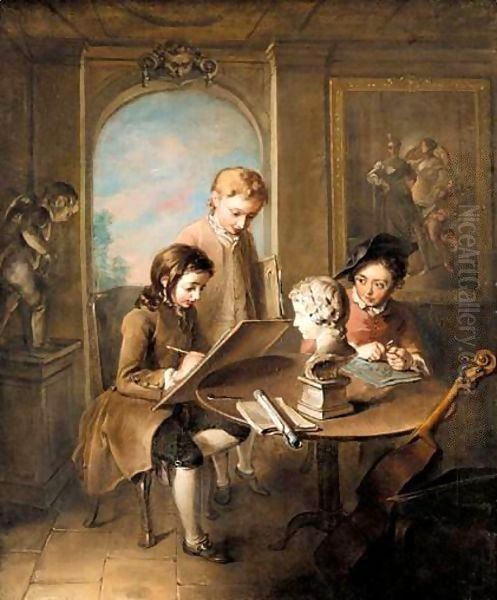
Within England, William Hogarth was a towering figure. While Hogarth also painted conversation pieces and his early work shows some Rococo influence (perhaps via Gravelot, with whom he was associated at the St. Martin's Lane Academy), his overall project was quite different. Hogarth's "modern moral subjects" like A Harlot's Progress or Marriage A-la-Mode were satirical and didactic, often critiquing contemporary society. Mercier's work, by contrast, was generally more decorative, less overtly critical, and aimed at pleasing rather than provoking. While both artists depicted contemporary life, their intentions and stylistic emphases diverged significantly.
Other painters of conversation pieces, such as Joseph Highmore and Arthur Devis, offered different takes on the genre. Highmore's figures often have a solidity and psychological presence, while Devis specialized in rather stiff, doll-like figures set in meticulously rendered landscapes or interiors, popular with the provincial gentry. Francis Hayman (1708–1776), another important contemporary, worked on a larger scale, producing historical subjects and decorative schemes (such as for Vauxhall Gardens), but also conversation pieces that sometimes shared Mercier's Rococo lightness.
The presence of other foreign artists in London also shaped the artistic landscape. The aforementioned Hubert-François Gravelot was highly influential as a draughtsman and teacher, promoting French Rococo design principles. The sculptor Louis François Roubiliac (1702/5–1762), another Huguenot émigré, was the leading sculptor in England during this period, working in a vibrant Rococo style that complemented the trends in painting.
Mercier's position as Principal Painter to the Prince of Wales would have placed him in a prominent, but also competitive, position. Patronage, especially royal patronage, was highly sought after, and artists constantly vied for commissions and favor. The eventual decline in Mercier's favor with Prince Frederick may have been due to changing tastes, the emergence of new artistic talents, or political machinations. For instance, the Italian painter Jacopo Amigoni (1682–1752) also enjoyed royal patronage in England during the 1730s, working in a decorative late Baroque/Rococo style.
Later Career, Mature Style, and Final Years
After his period of intense activity for the Prince of Wales in the 1730s, and his subsequent departure from royal favor, Philippe Mercier's career entered a new phase. From approximately 1739, he spent over a decade working primarily in the north of England, particularly in Yorkshire. This move suggests a need to find new sources of patronage away from the competitive London art world and the circles of court.
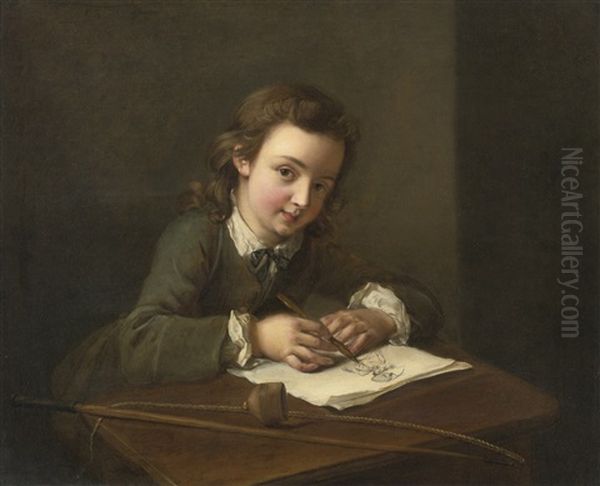
During his time in Yorkshire, Mercier continued to paint portraits and conversation pieces for the local gentry and prosperous merchant families. His style remained rooted in the Rococo, but perhaps adapted to the more conservative tastes of his provincial clients. The "fancy pictures," with their broad appeal, likely continued to be a staple of his output. This period demonstrates his resilience and the widespread appeal of his charming and elegant style, which found appreciation even outside the fashionable circles of the capital.
He returned to London around 1751. This was the year of Prince Frederick's death, an event that significantly altered the landscape of artistic patronage in England, as the Prince's court, which had been a hub of artistic activity, was dissolved. Mercier re-established himself in London, though perhaps without the same level of prominence he had enjoyed two decades earlier. The art scene was also changing, with new talents emerging and tastes gradually shifting. The generation of artists who would found the Royal Academy in 1768, such as Joshua Reynolds (1723–1792) and Thomas Gainsborough (1727–1788), were beginning to make their mark. Gainsborough's early work, in particular, shows a clear affinity with the Rococo style, and he may well have been influenced by artists like Mercier and Gravelot.
Little is documented about Mercier's very last years. He continued to paint and etch, but his output may have diminished. He died in London on July 18, 1760. By this time, the Rococo style, while still present, was beginning to cede ground to the emerging Neoclassicism and the more formal Grand Manner portraiture championed by Reynolds.
Legacy and Influence
Philippe Mercier's primary legacy lies in his role as a conduit for French Rococo aesthetics into English art. He was one of the earliest and most effective popularizers of this style in Britain, particularly through his conversation pieces and fancy pictures. His work offered a charming, elegant, and often intimate alternative to the more formal Baroque traditions that had preceded it.
His influence on the development of the conversation piece in England is significant. While not its sole inventor, he helped to establish its conventions and popularity, paving the way for other artists who specialized in this genre. His depictions of polite sociability and domestic harmony resonated with the values of the English aristocracy and the rising middle class.
Through his "fancy pictures," particularly series like The Senses, Mercier contributed to a taste for sentimental and decorative genre scenes that would remain popular throughout much of the 18th century. These works, often reproduced as engravings, reached a wide audience and helped to shape popular visual culture.
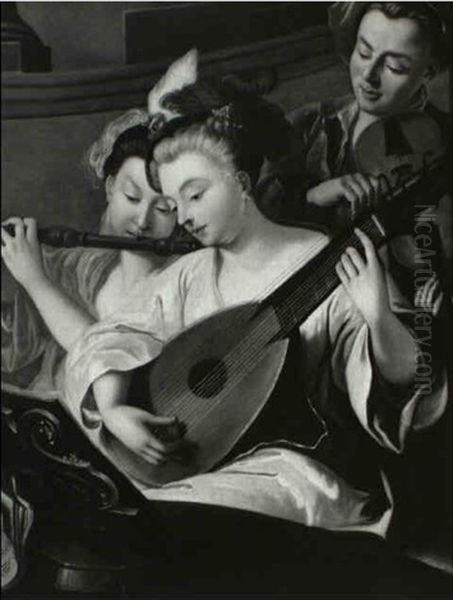
Mercier's association with Frederick, Prince of Wales, also had a lasting impact. The art patronized by the Prince's circle, including Mercier's work, helped to define a particular strand of English Rococo that was characterized by its grace, informality, and connection to a more liberal and culturally engaged faction of the elite.
While Mercier may not have achieved the towering posthumous fame of contemporaries like Hogarth or later figures like Reynolds and Gainsborough, his contribution was vital to the artistic developments of his time. He helped to broaden the range of subjects and styles available to English artists and patrons, and his work influenced a subsequent generation of painters. Early works by Thomas Gainsborough, for example, particularly his small-scale portraits and landscape settings, show a clear debt to the Rococo sensibility that Mercier helped to establish.
Today, Philippe Mercier's paintings are held in numerous public collections, including Tate Britain, the National Portrait Gallery in London, the Yale Center for British Art, and various regional museums in the UK and abroad. His work continues to be appreciated for its charm, technical skill, and its insightful depiction of 18th-century life and manners. He remains a key figure for understanding the complex interplay of continental influences and native traditions that shaped British art in the Georgian era.
Conclusion
Philippe Mercier, a painter of Franco-German origins, carved out a distinctive niche for himself in the English art world of the 18th century. From his training under Antoine Pesne in Berlin to his pivotal role in the circle of Frederick, Prince of Wales, Mercier consistently championed the elegance and charm of the Rococo style. His conversation pieces offered a new mode of informal group portraiture, while his "fancy pictures" captivated audiences with their sentimental and decorative appeal. Works like The Senses series and his musical portraits of the royal family remain iconic examples of English Rococo. Though his fame may have been eclipsed by later artists, Mercier's influence on his contemporaries and on the taste of a generation of English patrons was undeniable. He successfully translated continental artistic trends for a British audience, enriching the visual culture of his adopted country and leaving behind a body of work that continues to delight and inform.